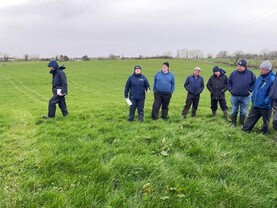After a challenging year for silage making, it’s as important as ever to know what quality your silage is sitting in the yard.
Silage making this year was an extremely challenging affair, with initial silage results on farms showing variable levels of feeding quality in silage.
While poorer quality silage in pits or bales can not be changed this year, identifying what key performance indicators your silage is falling down on may indicate what management practices need to be changed to make better quality silage next year.
It will also allow you to balance an animal’s diet by including the correct energy and protein in supplementary feeding.
Silage quality and testing were recently discussed on the farm of Oliver O’Hara, Leckaun, Co Leitrim as part of Teagasc/Animal Health Ireland (AHI) Autumn beef walks.
With Oliver operating a suckler to bull beef system alongside a mid-season lambing ewe flock, high quality silage is a necessity to reduce the volume of concentrates used to drive performance in what can often be a six-month winter in Leitrim.
DMD – target DMD: 70 DMD+
Dry Matter Digestibility (DMD) is the overall digestibility and feed value of silage and is a combination of factors.
Typical ranges are 55 DMD (very poor-quality silage or hay) up to 80 DMD + (leafy, young silage).
First cut silage on the O’Hara farm analysed at 79 DMD, with a mid-June cutting date, while second cut silage harvested in the first week of September came in at 70 DMD.
First cut silage ground was tightly grazed in spring with ewes and lambs prior to closing up.
The higher quality silage will be targeted at weanlings and calved cows, though second cut silage remains on the upper end of quality for feeding to dry cows.
Teagasc beef specialist Aidan Murray noted that ad-lib feeding of high-quality silage, such as Oliver’s, to spring calving cows could lead to cows becoming “mud fat when they calve down’’ and excessive restriction or supplementation of cows in the final 1/3rd of pregnancy would do little in the way of changing calf birth weight.
“If you want your spring calving cows in right condition, no sharp starving or sharp feeding as it doesn’t work, you need to be managing them from the time they come in.’’
Despite a wet summer where dry matter of silage suffered, Oliver has bucked the trend making some extremely high DM first cut at 43%, with second cut coming in at 29%.
A target of 25-30% DM for silage ensures that intake levels can be maintained without negatively affecting silage quality.
Lower DM silage will be difficult for animals to physically intake enough energy and protein as they intake more water weight.
Performance
However, extremely high DM silage, such as Oliver’s first cut, won’t necessarily drive performance above that of silage in the 25%to 30% DM bracket, with trials in Teagasc Grange indicating that while feeding very high dry matter silage increased dry matter intake, performance did not go up to the same extent.
Young stock in particular require a high protein diet and again high protein silage has a key role to play. Target protein percentage of grass silage is 13.5% or above, with Oliver again hitting this target with first and second cut silage at 15% and 14% respectively.
High protein silage can be married to lower protein concentrates without negatively affecting performance. This also has the positive effect of more home-grown grains such as barley and wheat being used in diets, reducing the need for imported proteins such as soyabean meal making up part of a ration.
Feeding potential
Where meal feeding to weanlings is taking place, Teagasc beef specialist Aidan Murray outlined that farmers that frontload the feeding of meal to lighter stock have seen increased performance, with weanlings unable to harness the true feeding potential of heavier cattle in regard to top quality silage.
“You are bringing a calf inside, taking its mother away from it and taking grass out of the diet and putting silage in front of them for the first time. They don’t have the capacity to take in the amount of silage they actually need to hit the target weight.
‘’With good quality silage you obviously need less concentrates,” he said. The farms that we have seen do well with calf performance fed them a bit more meal at the start when they took them in with the view to easing it back. “The farm that brought them in and fed them a kg at the start with the view to building them up always saw calves perform poorer.’’






 This is a subscriber-only article
This is a subscriber-only article










SHARING OPTIONS: